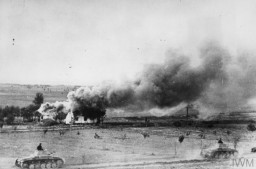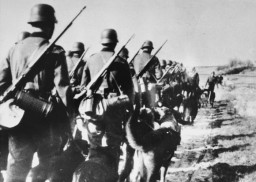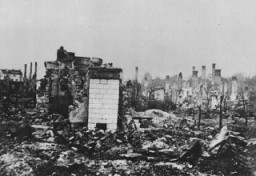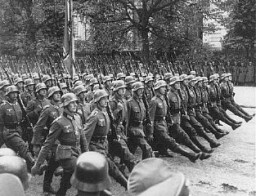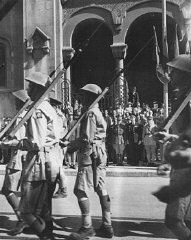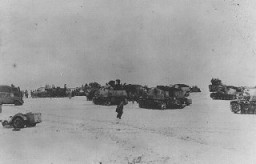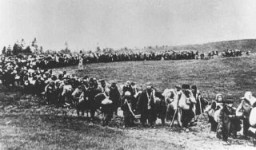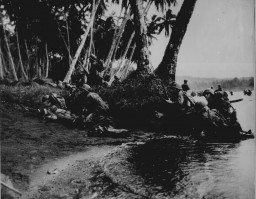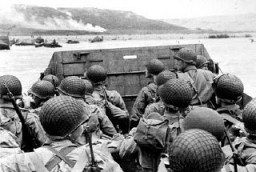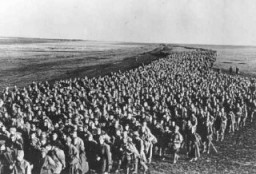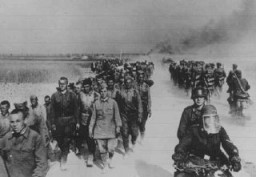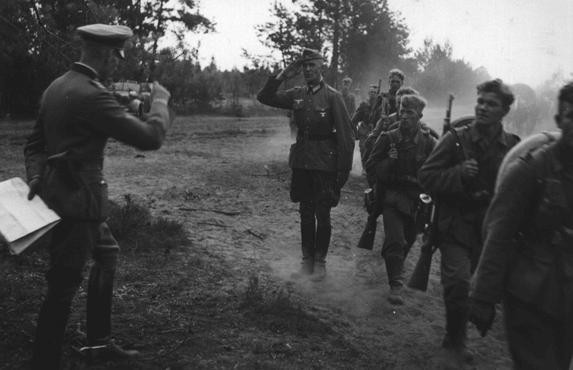
Invasion of the Soviet Union, June 1941
On June 22, 1941, Nazi Germany launched a surprise attack against the Soviet Union, its ally in the war against Poland. By the end of the year, German troops had advanced hundreds of miles to the outskirts of Moscow. Soon after the invasion, mobile killing units began the mass murder of Soviet Jews. German military and civilian occupation policies led to the deaths of millions of Soviet prisoners of war and Soviet civilians.
-
1
The destruction of the Communist Soviet Union and the conquest of “living space” in eastern Europe were longtime goals of Hitler and the Nazi Party.
-
2
Germany’s invasion of the Soviet Union, known as Operation “Barbarossa,” is considered one of the largest military operations in the history of modern warfare. Germany and its allies assembled more than 3,500,000 troops for the attack.
-
3
The German attack on the Soviet Union marked a turning point in both the history of World War II and the Holocaust.
Under the codename Operation “Barbarossa,” Nazi Germany invaded the Soviet Union on June 22, 1941. This was the largest German military operation of World War II.
Goals of the Invasion
Since the 1920s, core policies of the Nazi movement included:
- the destruction of the Soviet Union by military force;
- the permanent elimination of the perceived Communist threat to Germany;
- and the seizure of prime land within Soviet borders as Lebensraum (“Living space”) for long-term German settlement.
As such, Adolf Hitler had always regarded the August 23, 1939 German-Soviet nonaggression pact (commonly referred to as the Molotov-Ribbentrop Pact) as a temporary tactical maneuver. In July 1940, just weeks after the German conquest of France and the Low Countries (Belgium, Luxembourg, and the Netherlands), Hitler decided to attack the Soviet Union within the following year. On December 18, 1940, he signed Directive 21 (code-named Operation “Barbarossa”). This was the first operational order for the invasion of the Soviet Union.
From the beginning of operational planning, German military and police authorities intended to wage a war of annihilation against both the Soviet Union’s “Judeo-Bolshevik” Communist government and its citizens, particularly the Jews. During the winter and spring months of 1941, officials of the Army High Command (Oberkommando des Heeres-OKH) and the Reich Security Main Office (Reichssicherheitshauptamt-RSHA) negotiated arrangements for the deployment of Einsatzgruppen behind the front lines. The Einsatzgruppen would conduct mass shootings of Jews, Communists, and other persons deemed to be dangerous to establishing long-term German rule on Soviet territory. Often referred to as mobile killing units, they were special units of the Security Police and the Security Service (Sicherheitsdienst-SD). In addition, the German military planned that tens of millions of Soviet citizens would starve to death as the intentional result of German occupation policies.
The Invasion
With 134 divisions at full fighting strength and 73 more divisions for deployment behind the front, German forces invaded the Soviet Union on June 22, 1941. The invasion began less than two years after the German-Soviet Pact was signed. Three army groups attacked the Soviet Union across a broad front. These groups included more than three million German soldiers. The soldiers were supported by 650,000 troops from Germany’s allies (Finland and Romania). These troops were later augmented by units from Italy, Croatia, Slovakia, and Hungary. The front stretched from the Baltic Sea in the north to the Black Sea in the south.
For months, the Soviet leadership had refused to heed warnings from the Western powers of the German troop buildup along its western border. Thus, Germany and its Axis partners achieved almost complete tactical surprise. Much of the existing Soviet air force was destroyed on the ground. The Soviet armies were initially overwhelmed. German units encircled millions of Soviet soldiers. Cut off from supplies and reinforcements, the Soviet soldiers had few options other than to surrender.
As the German army advanced deep into Soviet territory, SS and police units followed the troops. The first to arrive were the Einsatzgruppen. The RSHA tasked these units with:
- identifying and eliminating people who might organize and carry out resistance to the German occupation forces;
- identifying and concentrating groups of people who were considered potential threats to German rule in the East;
- establishing intelligence networks;
- and securing key documentation and facilities.
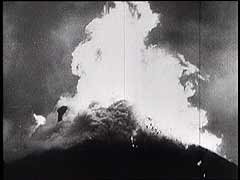
Mass Murder
The Einsatzgruppen initiated mass shooting operations. These mass shootings primarily targeted Jewish males, officials of the Communist Party and Soviet state, and Roma. They established ghettos and other holding facilities to concentrate large numbers of Soviet Jews, often with assistance from German Army personnel.
In late July, Heinrich Himmler's representatives (the Higher SS and Police Leaders) arrived in the Soviet Union. The SS and police, supported by locally recruited auxiliaries, began to shoot entire Jewish communities there. Hitler decided to deport German Jews to the occupied Soviet Union beginning on October 15, 1941. Contributing to this decision were the rapid advances both on the military front and in the murder of the Soviet Jews. The decision initiated the policy that would become known as the “Final Solution.” The “Final Solution” was the physical annihilation not only of Jews in the German-occupied East, but of Jews throughout Europe.

Military Offensives
The Soviet Union saw catastrophic military losses in the first six weeks after the German attack. However, the Soviet Union failed to collapse as anticipated by the Nazi leadership and the German military commanders. In mid-August 1941, Soviet resistance stiffened. This knocked the Germans off their timetable of winning the war by autumn 1941. Nevertheless, by late September 1941, German forces reached the gates of the Russian city Leningrad (today, St. Petersburg) in the north. They also took Smolensk, a city in Russia located over 200 miles southwest of Moscow, as well as Dnepropetrovsk (Dnipropetrovs’k; today Dnipro), a city in Ukraine located over 200 miles southeast of Kyiv. German forces spilled into the Crimean Peninsula in the south. They reached the outskirts of Moscow in early December.
After months of campaigning, however, the German army was exhausted. Having expected a rapid Soviet collapse, German planners had failed to equip their troops for winter warfare. They did not provide sufficient food and medicines, as they had expected their military personnel to live off the land of a conquered Soviet Union at the expense of the local population. Consequently, the Germans forces—overstretched along the 1,000 mile Eastern Front—became vulnerable to Soviet counterattack.
On December 6, 1941, the Soviet Union launched a major offensive against the center of the front. This drove the Germans back from Moscow in chaos. It took weeks for the Germans to stabilize the front east of Smolensk. In the summer of 1942, Germany resumed the offensive with a massive attack to the south and southeast toward the city of Stalingrad (Volgograd) on the Volga River and toward the oil fields of the Caucasus. In September 1942, the Germans reached the outskirts of Stalingrad and approached Groznyy in the Caucasus, approximately 120 miles from the shores of the Caspian Sea. This marked the farthest geographical extent of German domination in Europe during World War II.
Series: World War II
Series: Soviet Prisoners of War
Switch Series
Critical Thinking Questions
- In what ways was the German attack on the Soviet Union different from earlier invasions of other nations?
- Why was the initial invasion so successful?
- What was the relationship between the progress of the war and the mass murder of Europe’s Jews?
